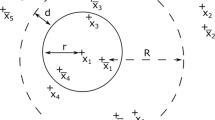Abstract
In this paper we prove the convergence of a suitable particle system towards the BGK model. More precisely, we consider an interacting stochastic particle system in which each particle can instantaneously thermalize locally. We show that, under a suitable scaling limit, propagation of chaos does hold and the one-particle distribution function converges to the solution of the BGK equation.
Similar content being viewed by others
Notes
This means that f solves the integral equation,
$$\begin{aligned} f(x,v,t) = \mathrm {e}^{-t} f_0(x-vt,v) + \int _0^t\!\mathrm {d}s\, \mathrm {e}^{-(t-s)} (\varrho _f M_f) (x-v(t-s),v,s)\,, \end{aligned}$$which formally derives from Eq. (2.2) via Duhamel formula.
If \(\mu \) and \(\nu \) are two probability measures on a metric space (M, d) with finite second moment, the 2-Wasserstein distance between \(\mu \) and \(\nu \) is defined as
$$\begin{aligned} {\mathcal W}_2(\mu ,\nu ) = \left( \inf _{\gamma \in {\mathcal P}(\mu ,\nu )} \int _{M\times M}\!\mathrm {d}\gamma (x,x')\, d(x,x')^2\right) ^{1/2}, \end{aligned}$$where \({\mathcal P}(\mu ,\nu )\) denotes the collection of all measures on \(M\times M\) with marginals \(\mu \) and \(\nu \). Here, \(M=({\mathbb T}^d)^j\times ({\mathbb R}^d)^j\) and \({\mathcal W}_2\big (f_j^N(t), g(t)^{\otimes j}\big )\) denotes the 2-Wasserstein distance between the probability measures with densities \(f_j^N(t)\) and \(g(t)^{\otimes j}\) respectively.
This process is called non-linear since its generator is implicitly defined through the law of the process itself, see Eq. (3.1) further on.
References
Bhatnagar, P.L., Gross, E.P., Krook, M.: A model for collision processes in gases. I. Small amplitude processes in charged and neutral one-component systems. Phys. Rev 94, 511–525, 1954
Cercignani, C., Illner, R., Pulvirenti, M.: The Mathematical Theory of Dilute Gases. Applied Mathematical Sciences, vol. 106. Springer, New York 1994
Greenberg, W., Polewczak, J.: A global existence theorem for the nonlinear BGK equation. J. Stat. Phys. 55, 1313–1321, 1989
Mustafa, D., Wennberg, B.: The BGK Equation as the Limit of an N–Particle System. J. Stat. Phys. 181, 715–737 (2020)
Olkin, I., Pukelsheim, F.: The distance between two random vectors with given dispersion matrices. Linear Algebra Appl. 48, 25–263, 1982
Perthame, B.: Global existence to the BGK model of Boltzmann equation. J. Differ. Eq. 82, 191–205, 1989
Perthame, B., Pulvirenti, M.: Weighted \(L^\infty \) bounds and uniqueness for the Boltzmann BGK model. Arch. Ration. Mech. Anal. 125, 289–295, 1993
Saint-Raymond, L.: From the BGK model to the Navier–Stokes equations. Ann. Sci. École Norm. Sup. 36, 271–317, 2003
Acknowledgements
The authors are very grateful to the anonymous referees for their valuable comments and suggestions which allowed several improvements to this work.
Author information
Authors and Affiliations
Corresponding author
Ethics declarations
Conflicts of interest
The authors have no conflicts of interest to declare that are relevant to the content of this article.
Additional information
Communicated by C. Mouhot
Publisher's Note
Springer Nature remains neutral with regard to jurisdictional claims in published maps and institutional affiliations.
Proof of Proposition 2.2
Proof of Proposition 2.2
We first observe that the smeared fields, defined in Eqs. (2.9), (2.10), and (2.11), coincide with the usual hydrodynamical fields associated to the smeared distribution function \(g^\varphi (x,v) := \int \!\mathrm {d}y\, \varphi (x-y) g(y,v)\), i.e.,
Therefore, according to [7, Proposition 2.1], we find the following pointwise estimates for \(\rho _g^\varphi \), \(u_g^\varphi \), and \(T_g^\varphi \):
In the above, \(C,C_q\) are constants independent of \(\varphi \) and
for a given positive function f.
As a consequence, following [7], we infer that
and hence, writing the equation for g in mild form and recallig Eq. (2.17), we obtain
The a priori bound \({\mathcal N}_q(g(t)) \le {\mathcal N}_q(f_0) \exp (C_q t)\) follows by the obvious inequality \( N_q( g^\varphi (s)) \le N_q( g (s))\) and the Grönwall’s lemma.
Provided with this estimate, by arguing exactly as in the proof of [7, Theorem 3.1], we construct the solution g(t) by establishing the Lipschitz continuity of the operator \(g \rightarrow \rho _g^\varphi M_g^{\varphi } -g\) in \(L^1( (1+v^2) \mathrm {d}x \mathrm {d}v)\) and using the standard iteration scheme. Moreover, exactly as in [7], the bounds (2.18), (2.19), and (2.20) follow from this construction and the previous a priori estimates.
Rights and permissions
About this article
Cite this article
Buttà, P., Hauray, M. & Pulvirenti, M. Particle Approximation of the BGK Equation. Arch Rational Mech Anal 240, 785–808 (2021). https://doi.org/10.1007/s00205-021-01621-y
Received:
Accepted:
Published:
Issue Date:
DOI: https://doi.org/10.1007/s00205-021-01621-y




